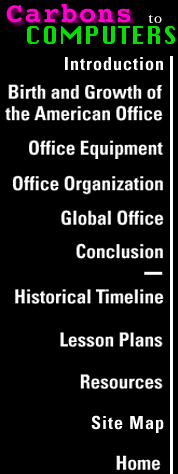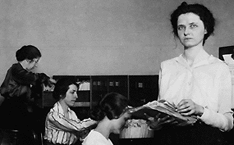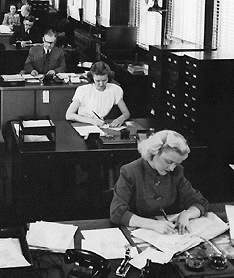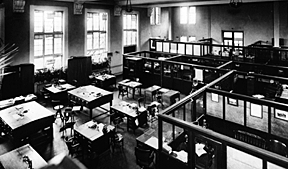
Scientific Management
Frederick Taylor began what was known as scientific management. In the 1880s, when most workers still labored in agriculture or factories rather than in offices, Taylor developed techniques in the steel industry that taught factory managers how to save money and increase productivity by making their employees more efficient. How the job was to be done was thought out by management; workers were mere instruments to execute the tasks.
 Throughout the nineteenth century, as American capitalism
built its industrial base, the factory system drew its labor force from
the peasant and village cultures of Europe. The huge wave of immigrants
who entered this country in the 1800s became the backbone of developing
mass production.
Throughout the nineteenth century, as American capitalism
built its industrial base, the factory system drew its labor force from
the peasant and village cultures of Europe. The huge wave of immigrants
who entered this country in the 1800s became the backbone of developing
mass production.
Taylor's principles were meant to separate the worker from his Old-World artisan culture--the idea that one person created an object, according to tradition and his own skill. The new order divided skills into a sequence of simple procedures to be taught to workers and monitored by management.
The rigidity and dehumanizing aspects of scientific management, from its beginning, engendered widespread working-class hostility. Nevertheless, it provided a general strategy which, in the long run, became the basic American approach to the structuring of labor processes.
 Scientific management's success in industry led
to its adoption in the office. Office managers knew too that time was money.
Soon there were clerks who only opened letters all day, clerks who only
typed, clerks who only filed, and couriers who picked up and delivered files
from one person to the next. Typists did not take shorthand, and clerks
who took shorthand (stenographers) did not file. Theoretically, valuable
company time was wasted when a stenographer left her desk to file.
Scientific management's success in industry led
to its adoption in the office. Office managers knew too that time was money.
Soon there were clerks who only opened letters all day, clerks who only
typed, clerks who only filed, and couriers who picked up and delivered files
from one person to the next. Typists did not take shorthand, and clerks
who took shorthand (stenographers) did not file. Theoretically, valuable
company time was wasted when a stenographer left her desk to file.
As only one way was seen to do a job, individual approaches to tasks were discouraged. Standardization made it easy for managers to keep a close eye on all workers and work flow, counting the typists' strokes or the number of letters opened per hour. Offices were often open spaces, without partitions, where desks could easily be watched.

Workers were kept to their jobs, which they pursued in silence. They were not allowed to talk because conversation cut down work time. Some employers put partitions between desks to keep talking to a minimum, even though they then had to patrol the floors.
By the 1920s any real difference between some office work and the factory production line had disappeared. The office, like the factory, was tedious and stressful for the worker and closely monitored by the manager.
Why did people tolerate these working conditions? As America
entered the Great Depression, people would do anything to keep their jobs.